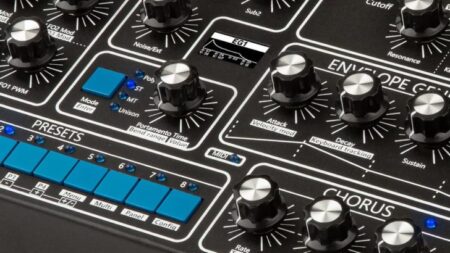GS-e7, a Multitimbral Analog Polyphonic Synthesizer
GS Music has introduced the e7, a new desktop synth that they say is the first analog polyphonic synthesizer ever made in Argentina.
The e7 is a 7-voice, 4-part multitimbral synthesizer that features a completely analog signal path, built-in effects, MPE support and more.
Features:
- Signal path – The signal path is completely analog, featuring two VCO per voice, a white noise source, a mixer, a 4-pole low pass VCF and a VCA. The control voltages are digitally generated, including 3 LFO, 2 ADSR-type envelope generators. Finally, it has a stereo digital effects processor with Delay and Chorus. LFO 1, LFO2 and the delay can be synced with the MIDI clock using a user selectable subdivision.
- Oscillators – It features two VCO plus sub oscillator per voice. Each oscillator has 3 different waveforms: triangle, sawtooth and saw-tri (triangle+sawtooth). There is a fine-tuning adjustment and a transpose option, allowing tune adjustment up to +/- 2 octaves. Tuning can also be modulated with any of the three LFOs and EG1. Each oscillator has a pulse wave that can be turned on or off, which is mixed with the other waveforms. Its pulse width can be modulated with LFO1 and/or EG1. Oscillators can be hard synced.
- The autotuning algorithm takes about 2 seconds to complete. All the voices are tuned in parallel, making a lot faster than usual.
- Mixer – The mixer can control the levels and mix the two oscillators, the suboscillators and the white noise or the external input.
- Filter – The filter is a 4-pole ladder-type low-pass filter with resonance control. It can be modulated with EG1, this modulation an also be affected by velocity. It can also be modulated with any of the 3 LFOs. It features keyboard tracking and it can be controlled by the modulation wheel or aftertouch.
- Chorus – There are two types of chorus available: basic and ensemble. The Basic algorithm is subtle and allows you to add some spatiality tothe resulting sound, while the Ensemble algorithm adds a different dimension to the sound, simulating a string or vocal ensemble. The Basic algorithm uses two delay lines, while the Ensemble uses 4 delay lines. Each delay line has its own internal LFO. There are controls for rate, depth and mix.
- Delay – The delay can be a stereo delay or a ping pong delay, with its maximum delay time being as long as 1.35s. It is possible to sync the delay to the MIDI clock too. If the delay is synced, the delay time knob controls the time division instead of the delay time. There are controls for the feedback and mix too.
- LFOs – There are three LFOs available. LFO 1 and 2 have 5 waveshapes: triangle, ramp up, ramp down, square and random with sample and hold. LFO 3 has the first 4 waveforms and is activated with the modulation wheel and/or aftertouch.
LFO frequencies go from 0.1Hz to 100Hz. Additionally, LFO 1 and 2 have different modes:
-
- Monophonic: The LFO is in phase for all of the voices.
- Polyphonic: The LFO is generated to a slightly different frequency for all of the keys pressed. This allows an interaction of the phases, generating more complex modulations.
- Keyboard Tracking (KB Tracking): The LFO frequency varies according to the note played following the chromatic scale.
- Keyboard Sync (KB Sync): The LFO is restarted when a key is pressed. Each voice has its independent LFO.
- Clock Sync: The frequency of the LFO is synced to the MIDI clock signal. The e7 automatically detects the BPM of the clock signal. It can be configured to generate different rhythmic figures.
- Keyboard + Clock Sync: The LFO frequency will be a sub-division of the MIDI clock signal. Also, the LFO will be restarted each time a key is pressed.
- Envelope generators – There are two ADSR-type envelope generators. There are controls for attack, decay, sustain and release. Attack and release can be modified by velocity and the envelope times have keyboard tracking.
- Stereo – By default, the voices have a stereo panning from left to right. By adjusting the stereo spread, it is possible to set all voices to the center or set them from right to left. There is also a stereo motion option that allows this stereo spread to be adjusted by an LFO.
- Presets – The synth can store up to 640 presets, 128 of them being multitimbral presets.
- Multitimbral – The synth can have up to 4 multitimbral parts. Each part has it complete sound configuration, assignable MIDI channel, keyboard zone, velocity zone, transpose setting and MIDI filter. Additionally, each part can have different voice assignments and/or share some voices.
- MIDI Polyphonic expression – MIDI Polyphonic expression is supported by the GS-e7. It was tested using GeoShred, allowing independent pitch control and cutoff for each voice.
The GS e7 synthesizer is available now for $1,499.


























